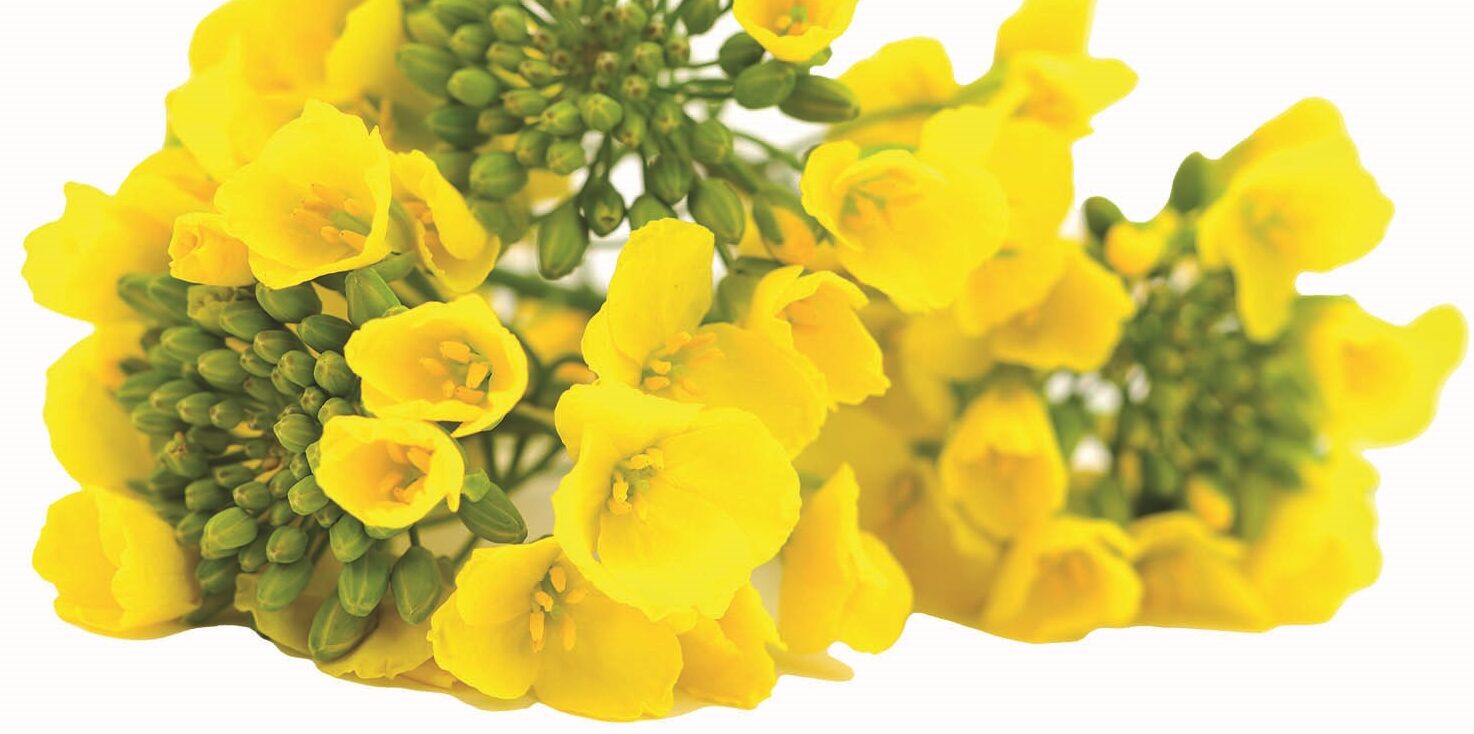The money makers
“Phosphorus might be a limitation for us. Our agronomist looked more closely at our removal rates, and what we thought was an adequate rate maybe wasn’t.”
–Margaret Rigetti
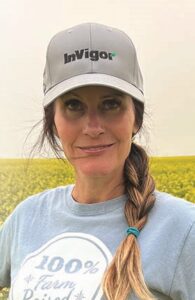 Margaret Rigetti
Margaret Rigetti
Langbank, Saskatchewan
Canola was the most profitable crop on Margaret Rigetti’s farm again in 2023. It usually is, she says. The farm grows three primary crops – canola, spring wheat and malt barley. “Canola grows so well in our area, in our soils, and it adapts to many growing conditions,” Rigetti says.
A tweak to phosphorus rates is one way to possibly improve canola profitability, she says. “Phosphorus might be a limitation for us. Our agronomist looked more closely at our removal rates, and what we thought was an adequate rate maybe wasn’t,” she says. “Thus, in 2023 we embarked on a multi-year phosphorus building program.”
The farm, as always, will try to control costs, grow more bushels and “market as well as we can,” Rigetti says. With prices down from their highs, cost management becomes more important, but when the farm’s other objective is to grow more bushels, “there’s only so much we can do,” she says.
The farm usually buys fertilizer in July because it “saves headaches” trying to sort it out any other time of year and prices are usually better than average in July. “Last year it was the wrong time, but our strategy usually works and we try not to switch it up, even if it ends up being wrong some of the time,” Rigetti says.
The farm takes the same approach to marketing. They have a strategy that factors in cost of production, cash flow needs, input from market advisory newsletters and averaging throughout the market year. “We do a variety of things, and we try to be consistent,” she says.
“We set up for the best crop possible and let Mother Nature take care of the rest.”
–Jeff Frost
 Jeff Frost
Jeff Frost
Olds, Alberta
Jeff Frost had record-breaking yields for all three of his crops in 2023. Barley was the most profitable with “ridiculous yields” and malt grade. Canola was close behind, he says. Wheat also did well.
“We were always a couple of days from a complete wreck in 2023, but got timely rains and no hail,” Frost says. “Canola looked good all year. Lots of plant material and lots of bushels, too. It was worth the fight at harvest.”
Frost does not skimp on inputs to cut costs. “We set up for the best crop possible and let Mother Nature take care of the rest.” The budget includes “aggressive” fertilize rates, two applications of Liberty and fungicide for sclerotinia stem rot. “We have seen some wrecks from sclerotinia stem rot,” he says.
The high inputs approach works out very well on years like 2023. “But the previous few years our canola has been a dog, with high inputs, low yields and hail.”
Frost always buys hail insurance. “It is necessary to sleep at night.”
He doesn’t have any major profit-enhancing changes in mind. He currently floats on elemental sulphur and might consider trying MicroEssentials S15 in the seed row. The granular fertilizer contains nitrogen, phosphorus and sulphur, with the analysis 13-33-0-15. He says their fields are not sulphur deficient, but S15 provides more precise and uniform distribution than the floated elemental.
Frost wishes he had been more aggressive selling canola this year. By mid December, canola prices had fallen to about $14 per bushel, down from $20 a few months earlier. “Canola is still profitable at $14 as long as you get the yield,” he says.
He keeps his rotation consistent. “We take a whole farm approach and won’t switch up acres to chase last year’s prices.”
“It doesn’t matter how much you grow if you don’t market it well.”
–Evan Michel
 Evan Michel
Evan Michel
St. Gregor, Saskatchewan
Canola was Evan Michel’s most profitable crop in 2023. “It was looking average all year, and ended up better than expected,” he says. “It was nice to see.”
Even with prices in early January lower than at harvest, canola will still be “reasonably profitable,” Michel says.
Second place, for him, went to red lentils. He used to grow green peas as his pulse crop, and two years ago tried red lentils for the first time. This year he made a full switch. His father-in-law, who farms in southern Saskatchewan near Lafleche, encouraged him to try the lentils. His other crops are wheat and barley.
When asked how he could make canola more profitable, Michel mentioned fungicide to manage sclerotinia stem rot. He sprayed this year, but being such a dry July, he says “it helped a little, but on years with more disease pressure it can help more.”
Another big factor in profitability is marketing. “It doesn’t matter how much you grow if you don’t market it well,” Michel says. He pre-sold some canola before harvest, but “not enough,” he says. “I’m not used to seeing the price drop this much.”
He doesn’t plan to change his marketing approach, which is to forward-contract a percentage of the anticipated crop. However, the lower canola price does make him more mindful of his break-even point.
“We have always had blackleg pressure, not severe but costing yield.”
–Sheldon Guthrie
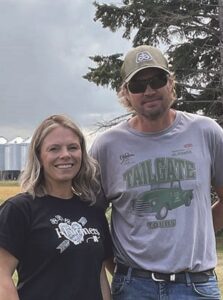 Andrea and Sheldon Guthrie
Andrea and Sheldon Guthrie
Reston, Manitoba
The Guthrie’s were in the “have not” zone for moisture in 2023, with 2” of growing season rainfall around the home farm. “Some crops only got an 1” of rain after planting,” Sheldon says.
Not counting insurance payments, their 2023 crops, ranked by profitability, were corn, wheat, canola, peas and soybeans. “Corn did well despite the lack of rainfall, and wheat was better than expected, by far,” Sheldon says. Canola didn’t do well and peas and soybeans were “terrible.”
Guthrie is testing longer breaks between canola crops to see if that improves profitability. A few years ago, canola on a two-year rotation was dying prematurely. He didn’t get it tested, but assumed disease. Then it happened again two years later and he got it tested. The canola had verticillium stripe and blackleg. “We have always had blackleg pressure, not severe but costing yield,” he says. So they want back to a four-year rotation on fields that had been in the two-year rotation. Those fields are just coming back into canola in 2024, so the Guthries haven’t had a chance to test the rotation benefit.
“When you look at the health of canola plants going into land that hasn’t had canola for 10 or 15 years, because the land was in forage, you can see how longer breaks can help with disease management,” Sheldon says.
Canola farmers can manage tight rotations with fertilizer and fungicides, and many farmers do that. Going north from Reston, canola yields and profitability go way up, Sheldon says, while corn becomes inconsistent.
With fewer profitable rotation crops, this drives tighter canola rotations.
As seed growers and agronomy specialists, the Guthries see value in a more diverse rotation. And corn seems to like the growing conditions around Reston. “I’ve been growing corn for 12 years and it has been my most profitable crop every year I’ve grown it,” Sheldon says. “It is resilient in our environment. It does well in heat.” His worst year for corn was a wet fall. The crop came off really tough and “drying costs were through the roof.”
“If we had set some better price targets, maybe we would have taken advantage of those prices.”
–Cheryl Westman
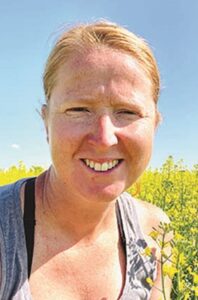 Cheryl Westman
Cheryl Westman
Vermilion, Alberta
Cheryl Westman’s most profitable crop in 2023 was hard red spring wheat. “That surprised us,” she says. “We thought it would be soft white wheat.” Most years their most profitable crop is canola. She and her husband Kyle went through the numbers in preparation for this panel topic. They calculated their hard red spring average yield at 90 bu./ac. Soft white was about the same, but hard red prices are better.
Oats were second, also driven by very good yields. “We had to bag some of our oats this year because we ran out of bin space on the farm,” Westman says. It was a good cereal growing year for many farms within central Alberta, especially in the clay soils around Vermilion.
Canola was third, in a tight cluster with soft white wheat and barley. Canola yields are usually 50 to 55 bu./ac. on the Westman farm. They were 40 bu./ac. in 2023. “Our canola got some heat during flowering, so we’re thinking that is why yields were lower,” Westman says.
Better marketing could have improved their canola profitability this year, Westman says. Marketing often includes some hindsight regret, and this year the Westmans wish they would have sold some canola into the summer rallies. January 2024 canola futures, for example, were over $800 per tonne for most of the summer then began a long slide to around $650 on December 20. “If we had set some better price targets, maybe we would have taken advantage of those prices.”
Even at current prices, Westman says their 2023 canola is still profitable. “We know what we need to cover for input costs and we should be able to sell above that, even though prices have dropped off.”
“We don’t have a lot of experience with kochia here, and it’s something I want to keep on top of.” – John Bergen
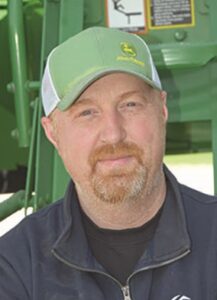 John Bergen
John Bergen
Carman, Manitoba
Canola was John Bergen’s most profitable crop in 2023. Yields were near 60 bu./ac. – “much better than anticipated,” Bergen says. “The crop did really well in conditions you wouldn’t think it would.” The farm got about 5” of in-season rainfall and the crop tapped into decent soil moisture reserves. Canola benefited from a cooler July – cool weather at flowering contributes to better seed set and higher yield potential – and long dry fall that allowed Bergen to take his time at harvest.
His soybeans, on the other hand, looked “all right for a while” but yield comes down to seed size, Bergen says, and the dry fall did not provide the required moisture to fill the seeds. “Harvest conditions good for soybean yield would be considered awful for canola and cereals,” Bergen says. And since harvest conditions were great for canola and cereals, it means soybeans suffered.
When asked about canola practices he may look to improve in 2024, Bergen highlighted a few practices he “did right” in 2023 and will keep doing. One was later seeding. Canola seeds planted into warm soils really took off after a timely, though not huge, June rain. This may have been a factor in lower flea beetle pressure. Bergen also applied pre-harvest diquat desiccant using their own ground sprayer equipped with crop dividers to reduce trampling. Choosing this over custom aerial application “put the money in our own pocket,” he says.
Bergen will more closely scrutinize fungicide applications. In the Red River Valley, farmers will usually spray to protect canola from sclerotinia stem rot without much consideration for risk factors. Granted, the risk is usually there. However, in 2023, Bergen left some untreated checks because he wasn’t sure the drier conditions would provide a return on investment for fungicide. His hunch was correct. There was “zero difference” between treated and untreated strips.
Bergen will also “spice up” his weed control, especially to target kochia, a relatively new problem. “We don’t have a lot of experience with kochia here, and it’s something I want to keep on top of.”





